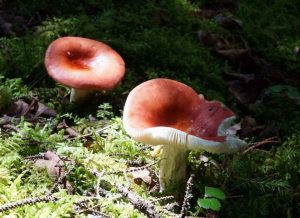
Fruiting body of a Russula mushroom in a local red oak woodland. Hyphae of Russula mushrooms connect shrubs and trees in a mutualistic network.
Her research demonstrates that in western forests, Paper Birch and Douglas Fir share photosynthetic products via their mycorrhizal networks, also that mature Douglas Fir actually nurture their young.
Think of the implications for our Acadian Forest: could Yellow Birch and Red Spruce be sharing such communications, old and young Red Spruce? Clearcutting our naturally mixed, multi-aged Acadian forests can hardly foster such connections!
The video concludes:
“I want to leave you with four simple solutions. And we can’t kid ourselves that these are too complicated to act on.
“First, we all need to get out in the forest. We need to reestablish local involvement in our own forests. You see, most of our forests now are managed using a one-size-fits-all approach, but good forest stewardship requires knowledge of local conditions.
“Second, we need to save our old-growth forests. These are the repositories of genes and mother trees and mycorrhizal networks. So this means less cutting. I don’t mean no cutting, but less cutting.
“And third, when we do cut, we need to save the legacies, the mother trees and networks, and the wood, the genes, so they can pass their wisdom onto the next generation of trees so they can withstand the future stresses coming down the road. We need to be conservationists.
“And finally, fourthly and finally, we need to regenerate our forests with a diversity of species and genotypes and structures by planting and allowing natural regeneration. We have to give Mother Nature the tools she needs to use her intelligence to self-heal. And we need to remember that forests aren’t just a bunch of trees competing with each other, they’re supercooperators.”
—–
A Tip of the Hat to C.C. of the NS Wild Flora Society for bringing this video to my attention.
